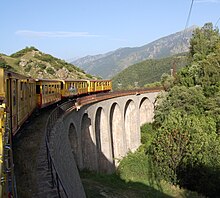|
Ligne de Cerdagne
The Ligne de Cerdagne (French pronunciation: [liɲ də sɛʁdaɲ]), usually referred to as Le Petit Train Jaune (English: Little Yellow Train, Catalan: Tren Groc), is a 1,000 mm (3 ft 3+3⁄8 in) gauge railway that runs from Villefranche-de-Conflent to Latour-de-Carol-Enveitg in the French Pyrenees. History of the LineThe section of line between Villefranche-de-Conflent and Bourg-Madame was declared a public utility by law on 4 March 1903. This same law approved the granting of a concession for the line, signed on 5 December 1902, between the Minister of Public Works and the Compagnie des Chemins de Fer du Midi et du Canal Latéral à la Garonne. The law also superseded an earlier proposed standard gauge railway which had been authorised between Villefranche-de-Conflent and Olette, but never built.[1] A second law was approved on 23 March 1914 to extend the railway from Bourg-Madame to the 'French frontier station' of the transpyrenean line from Ax les Thermes to Ripoll, although the present station name at the terminus of Latour de Carol Enveitg was not mentioned.[2] The declaration of public utility for this section of the line was confirmed on 4 September 1922.[3] Construction started in 1903 and the section to Mont-Louis was completed in 1910, followed by the extension to Latour-de-Carol in 1927.[4][5] Description of the LineThe line is 63 kilometres (39 mi) long and climbs to 1,593 metres (5,226 ft) at Bolquère-Eyne, the highest railway station in France. The line serves 22 stations, fourteen of which are "request stops" (i.e., the train only stops when specifically requested by passengers). There are 19 tunnels, the longest of which is the Tunnel du Pla de Llaurar with a length of 380 metres (1,250 ft), located at kilometre point 59.639.[6] Amongst the various structures along the line are two viaducts over the River Têt classified as Historic Monuments because of their architectural and technical importance:
  The line is single-track with passing loops at, for example, Mont-Louis and Fontpédrouse-Saint-Thomas-les-Bains. The trains are powered by electricity at 850 volts DC, supplied by third rail. The power is supplied by hydro-electric generators on the River Têt. The maximum speed of the train is 55 km/h (34 mph). Two types of train are used: ones using modern, entirely closed two-car multiple units, and others using old-style trailer carriages and powered carriages - most are enclosed, though open carriages are also used when the weather allows. The open carriages allow dramatic views as the train traverses the twisting route and are popular with tourists. Line maintenance vehicles are stored at Villefranche-de-Conflent. It is named after its yellow and red colours, derived from the Catalan flag. The line was constructed to provide an all-weather route from the high Cerdagne valley to the coast but, as the adjacent N116 road has been progressively improved, there has been population loss in the Cerdagne and the rail link is now chiefly a tourist attraction. Though its long-term future was in doubt in 2017,[10] 80 million euros was invested in the line between 2010 and 2023 by the agency 'Plan Rail'.[9] List of stations
Electrical dischargesIn 1911, railway workers reported a fireball on the third rail between kilometres 28 and 40. A similar phenomenon occurred again when a train was hit by one of these fireballs during a thunderstorm. Lightning rods were installed where these events had occurred and the phenomenon has not been reported since installation. See alsoReferences
External linksWikimedia Commons has media related to Ligne de Cerdagne.
|
|||||||||||||||||||||||||||||||||||||||||||||||||||||||||||||||||||||||||||||||||||||||||||||||||||||||||||||||||||||||||||||||||||||||||||||||||||||||||||||||||||||||||||||||||||||||||||||||||||||||||||||||||||||||||||||||||||||||||||||||||||||||||||||||||||||||||||||||||||||||||||||||||||||||||||||||||||||||||||||||||||||||||||||||||||||||||||||||||||||||||||||||||||||||||||||||||||||||||||||||||||||||||||||||||||||||||||||||||||||||||||||||||||||||||||||||||||||||||||||||||||||||||||||||||||||||||||||||||||||||||||||||||||||||||||||||||||||||||||||||||||||||||||||||||||||||||||||||||||||||||||||||||||||||||||||||||||||||||||||||||||||||||||||||||||||||||||||||||||||||||||||||||||||||||||||||||||||||||||||||||||||||||||||||||||||||||||||||||||||||||||||||||||||||||||||||||||||||||||||||||||||||||||||||||||||||||||||||||||||||||||||||||||||||||||||||||||||||||||||||||||||||||||||||||||||||||||||||||||||||||||||||||||||||||||||||||||||||||||||||||||||||||||||||||||||||||||||||||||||||
